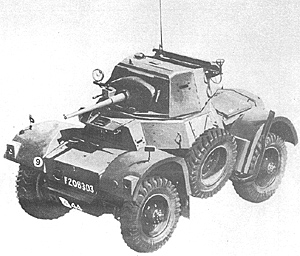
Recently I was asked by a B.B.C. London radio programme to take part in a "Phone-in" programme dealing with wargaming. Unable to accede, I asked Neville Dickinson, that genial owner of Miniature Figurines, if he would go up to London as an able substitute. This he did and seemingly thoroughly enjoyed himself in a lively and stimulating programme which aroused enough interest for the 'phone never to stop ringing throughout.
Daimler Armoured Car from a book by B.T. White (artist Jack Wood) published by Blandford Press
My reason in mentioning this arises from Neville's remark that the majority of people who phoned in (mostly younger wargamers) expressed the opinion that they found wargaming rules too complex and hard to understand, that they slowed tip the game and tended to cause initially keen wargamers to tire of the hobby and abandon it. This is no new criticism, in fact it is highly topical and a number of experienced wargamers have expressed the opinion that rules have gone beyond the point of allowing a realistic and fast-flowing game so causing them to yearn for a return to the "back of a postcard" rules of their earlier days. No less a person than Phil Barker, joint compiler of the excellent rules of the Wargames Research Group, expressed almost that view in an article in the Newsletter a few months ago.
I have never made any secret of the fact that I find most commercial sets of rules to be far more complicated and embracing than I care to accept - but then I am on record as being of the opinion that there must be two sorts of rules - one for the parochial group of wargamers who play friendly give-and-take games in their own homes and others for the competitive wargamers who seek to extract every advantage from the wording of rules so that they must be formulated to allow but a single interpretation of each of their phases. There are those amongst us who will undoubtedly cry that they merely seek realism and authenticity - as we all do but there comes a point when that search goes over into the border of almost unplayability.
Table-top wargaming can only bear an almost coincidental resemblance with real war and the very nature of its scaling-down of organisations, numbers and distances must mean that a wide stretch of the imagination is required to make it resemble the battles we are attempting to portray. That being the case, why do wargamers continue to search for a sort of El Dorado of realism? Why not say - "This is as far as our rules are to go, we realise that they could go much further in their search for realism but in so doing they will destroy smooth, fast and enjoyable playability!" It is the fashion amongst the more trendy wargamers to sneer at the relatively simple attitude taken towards the hobby in many of my books, all of which aim at establishing a basis of simple, workable rules upon which the individual wargamer can superimpose aspects that reflect his own temperament and personality.
Under such rules generations of wargamers have enjoyably fought and rarely bickered in my Southampton wargames room - arid I trust will continue to do so to rules that, with an established base for all periods, each provide adaptations and slants which bring out the specific aspects of the period and type of warfare we are fighting. Do not scorn simplicity in wargaming, enjoy the hobby and do not allow yourself to get bogged down with extraneous details. H.G.Wells and Robert Louis Stevenson were eminent authors, intelligent and thoughtful men - their rules were the very peak of simplicity - can you say that they were wrong?
Back to Table of Contents -- Wargamer's Newsletter # 171
To Wargamer's Newsletter List of Issues
To MagWeb Master Magazine List
© Copyright 1976 by Donald Featherstone.
This article appears in MagWeb (Magazine Web) on the Internet World Wide Web.
Other articles from military history and related magazines are available at http://www.magweb.com